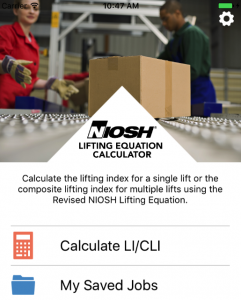NLE Calc: A Mobile Application Based on the Revised NIOSH Lifting Equation
Posted on by
 Knowing how much weight an individual worker can safely lift is a key component to preventing back injury in the workplace. NIOSH recently released a free mobile lifting application, NLE Calc, which helps users determine safe lifting limits. The new NIOSH app takes information from the internationally renowned “Revised NIOSH Lifting Equation” out of the laboratory and into the hands of workers and employers.
Knowing how much weight an individual worker can safely lift is a key component to preventing back injury in the workplace. NIOSH recently released a free mobile lifting application, NLE Calc, which helps users determine safe lifting limits. The new NIOSH app takes information from the internationally renowned “Revised NIOSH Lifting Equation” out of the laboratory and into the hands of workers and employers.
What is NLE Calc?
The NIOSH Lifting Equation Calculator app (NLE Calc) allows users to quickly calculate manual lifting risks as they occur on the job. NLE Calc even uses the composite lifting index (CLI)—often ignored by commercially available apps—to calculate manual lifting risks for multiple and complex lifting tasks. Workers, employers, and occupational health professionals can easily download NLE Calc from Apple iTunes or Google Play, type the indicated measurements into the equation, and use the results to help identify ergonomic solutions for reducing the physical stresses associated with manual lifting.
What are the key benefits of using NLE Calc?
- Calculates the composite lifting index (CLI) for multiple lifting tasks (often ignored by most commercial apps)
- Uses equations approved by NIOSH ergonomists, who created the NIOSH Lifting Equation (NLE)
- Promotes better musculoskeletal health
- Raises workers’ awareness about their job tasks
- Helps workers and employers make informed decisions about potential musculoskeletal hazards
- Serves as job design guidelines for manual lifting tasks
- Can be used as a research tool to collect manual lifting data

With the app’s release, NIOSH added a page on our website specifically dedicated to NLE Calc. This webpage offers more information on how to use the app and how to interpret the results.
The cost of musculoskeletal disorders is a serious health concern. Around the world, musculoskeletal disorders are responsible for roughly 21% of the years people live with disabilities.1 In 2010, low back pain and neck pain were among the top five leading causes of disability worldwide. 1 In the United States and Canada, more people are unable to work because of musculoskeletal disorders than because of any other group of diseases.2
For over 20 years, the Revised NIOSH Lifting Equation has been the international standard for assessing risks associated with lifting tasks, preventing the onset of lower back pain, and reducing work-related musculoskeletal disorders. As you use the app, please tell us about your experience in the comment section below. We would also appreciate your help in getting the word out about the app.
Emily Warner, MA, is an ORISE Fellow in the NIOSH Division of Applied Research and Technology.
Stephen D. Hudock, PhD, CSP, is Manager of the NIOSH Musculoskeletal Health Cross-Sector.
Jack Lu, PhD, CPE, is a Research Ergonomist in the NIOSH Division of Applied Research and Technology.
References
1 Hoy DG, Smith E, Cross M, Sanchez-Riera L, Blyth FM, Buchbinder R, Woolf AD, Driscoll T, Brooks P, March LM. [2015] Reflecting on the global burden of musculoskeletal conditions: lessons learnt from the Global Burden of Disease 2010 Study and the next steps forward. Ann Rheun Di; 74:4-7.
2 Punnett L, Pruss-Ustun A, Nelson DI, Fingerhut MA, Leigh J, Tak S, Phillips S. [2005]. Estimating the Global Burden of Low Back Pain Attributable to Combined Occupational Exposures. AJIM; 48: 459-469.
Posted on by


